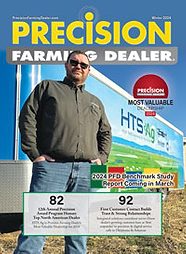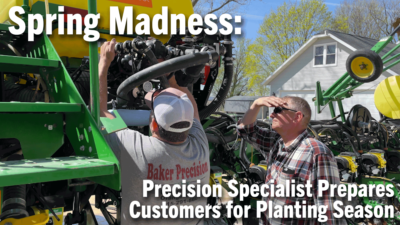After more than 2 years working as an AMS specialist at a John Deere dealership in Northeastern Colorado, Haley Harms had an epiphany.
“I realized after 18 months, supporting over 500 customers and 5 dealerships, there was no one out there able to explain to farmers how GPS (Global Positioning System) and RTK (Real Time Kinematic) worked,” she says. “It was then that I realized that I could help my Trimble neighbors, as well as my Outback neighbors, and anyone who wasn’t getting the answers they were looking for, because no one could explain to them the basics of how and why these things work the way they do.”
After that realization, Harms left the dealership to form Pro Till, an independent precision farming company, in August 2011. She created Pro Till to help farmers learn to use their GPS and guidance platforms to their highest potential and maximum productivity.
“Farmers are mechanically inclined and want to understand the ‘how’ and the ‘why,’ Harms says. “My goal is to teach the farmer, on his or her own system, to the point that they can troubleshoot in the field, and operate at maximum efficiency, without relying on tech-support for basic issues.”
In a recent study published by the United States Department of Agriculture, titled, On the Doorstep of the Information Age – Recent Adoption of Precision Agriculture, the authors, David Schimmelpfennig and Robert Ebel, stated:
“Recent data from the Agricultural Resource Management Survey (ARMS) show that use of yield monitors, often a first step in utilization of precision technology for grain crop producers, has grown most rapidly, being used on 40-45% of corn and soybean acres in 2005-06. However, farmers have mostly chosen not to complement this yield information with the use of detailed Global Positioning System (GPS) maps or variable-rate input applicators that capitalize on the detailed yield information. Some of the factors that could be contributing to this adoption lag include farm operator education, technical sophistication, and farm management acumen.“
From Harms’s perspective, the adoption rate of precision agriculture technology appears to be more operation-specific than anything.
“Adoption is more driven by the operation and how much water you have as to how quickly you adopt new technology and see a return on your investment,” she says. “These farmers can purchase five, $30,000 systems at one time, and realize $60,000 back in their pocket since their operational cost decreased due to less spray, less fuel and other tangible savings. They see it so much faster so they are willing to invest in it faster.”
On the contrary, Harms sees that dryland farmers adopt to new technology much slower and in smaller increments than the large, irrigated farmers who are dealing with a much larger cash flow and larger acreages resulting in more bushels per acre.
“For dryland farms, which are generally family-run operations, a $10,000-$15,000 GPS system is a lot bigger expenditure,” she explains. “They too realize that this technology will pay for itself and, when they see that return on their investment, they quickly adopt it on everything on their farm: combines, sprayers, and the like.”
Measuring the effectiveness for many of these users starts anecdotally. They incorporate RTK precision with their liquid and section control applicators and may find that they have 100 gallons remaining after spraying 80 acres. After 3,000 acres, those gallons really add up and farmers can see the savings this technology brought them.







Post a comment
Report Abusive Comment